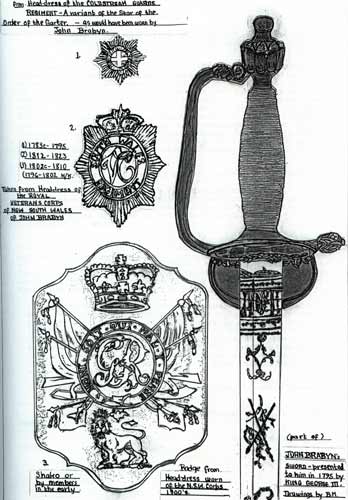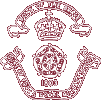| Navigation links at the bottom of this page |
|
| How
Sergeant Brabyn saved Frederick, Duke of York |
|
| During
the 2006 Remembrance Day service in Victor Harbour, Australia, Edward
Grant (R1940-45) added two white roses to the official wreath laid
at the cenotaph. At the ceremony, the president of the RSL welcomed
the ex-Dukies present. Later, Mrs. Carlene Farmer told Ted that one
of her husband's forebears had once saved the life of HRH Frederick,
Duke of York. Mrs. Farmer copied the following extract from their family
history, 'The Life and Times of John Brabyn of the NSW Corps and His
Extended family' by Betty McGrath, a direct descendent of John Brabyn
and the present custodian of the King's Sword and other artifacts of
John Brabyn. She lives in Sydney, Australia. As Ted Grant remarked, "If
it were not for John's swift action in Flanders in the late 1790s,
there might well have been no Duke of York's Royal Military School
today. Extract from 'The Life and Times of John Brabyn of the NSW Corps
and His Extended family'. |
 |
After France declared
war on England on Feb 1st 1793, George III gave his son, the 30 year
old Duke of York, command of the English contingent, wisely bolstering
him with senior advisers. Prince Frederick was immediately dispatched
to Flanders in the Austrian Netherlands in command of 5,000 armed
men. The forces were sent to support the General in overall charge
of the Allied Forces on the Continent, the Austrian Prince Saxe-Coburg.
(Present day Belgium forms part of this area). John Brabyn "A
true and trusted steady sergeant in the foot guards" was chosen
to be part of the Duke's personal bodyguard. We know that John was
tall, strong and had previously served under the Duke's command when
a private in the foot guards, some years earlier.
The
Flanders campaign, particularly from 1793-1795, came under the overall
Leadership of Prince Saxe-Coburg, the Austrian General, who opened
the Allied offensive with a 40,000 strong Army and advanced into
Belgium on March 1st 1793. The wonderful Lippizzaner horses were
raised near Gratz in Austria. The Duke of York and Brabyn would certainly
have had these beautiful horses.
Coburg led his troops on to the Southern Netherlands on 18th March
where they encountered and beat the French, who had invaded Holland
at Neerwinden. Prince Frederick and his faithful bodyguard, John
Brabyn featured in this battle. The British troops found themselves
encircled and threatened with annihilation. Although it was a chaotic
and desperate action and they suffered heavy losses, they managed
to regain the Allied lines. They were being mercilessly hounded by
the enemy and "by superb effrontery, the Duke of York escaped
capture, at one point galloping in front of his two escort squadrons
of Dragoons in a dramatic chase over hedge and dyke with the Star
of the Garter gleaming at his breast." |
|
The King's sword
presented to
Sergeant John Brabyn
by King George III |
 |
 |
|
| The Duke's own account of
this episode played down the whole encounter. He wrote "Thus
completely cut off from my corps, nothing remained for me to do, but
to force my way to that of General Otto (his Austrian Ally), and to
concert measures with him, to free my own troops. This I effected,
accompanied by a few Dragoons of the 16th Regiment, with great difficulty" |
Major -General Craig, described the ducal plight as "the misbehavior
of another Austrian Battalion left us so completely exposed that his
Royal Highness was litterally (sic) cut off from every part of his
Army and was under the necessity of making his way, sword in hand,
to General Otto's Column, in doing which he received fire at 50 yards
distance an officer was killed by his side".
As a personal bodyguard,
Brabyn would have had permanent place in the Duke's own entourage
of which no record could be found. However this appears to have been
the occasion when they were riding side by side, fleeing the enemy.
The Officer on one side of the Duke was shot. The Prince's own horse
was shot from beneath him in a volley of grape, John, riding alongside
and protecting the Duke's other flank, was able to quickly hoist
the royal personage on to the rear of his horse and gallop to safety.
King George III presented John Brabyn with his personal sword in
honor of the occasion when he saved the Duke of York's life in Flanders.
This treasured possession is still in the hands of descendants of
John Brabyn.
George III is also said to have offered John a title, to which he replied
that as a King's man he was only doing his duty. John also received
his commission, without purchase, in the New South Wales Corps, the
very day he and the Duke set foot back on English soil, 5th May 1795,
by the King's own command. |
 |
Markings on Sword presented
to Sergeant
John Brabyn
by King George III |
|
 |
|
|
The NSW Corps had embarked
on board the 'Marquis Comwallis', Captained by Michael Hogan, at Portsmouth
on 6th June 1795. John Brabyn did not join the ship until a month later
at Cork. By this time the detachment consisted of two ensigns, one sergeant
one corporal, and 26 privates. There were 163 male and 40 female Irish
convicts consigned to board the ship at Cork, without any papers as to
their crime or term of sentence.
Mary Brabyn and her
two infants traveled by coach, then sea and boarded the ship and on the
9th of August they all sailed out of the port for a long 186 day voyage
to Sydney. Mary was the only free woman on the ship. There was also a
mutiny during the voyage. They arrived in Sydney on Feb 11th 1796. After
6 weeks, Brabyn was sent to Norfolk Island, and 3 weeks later Mary died.
She was the first free woman to die on Norfolk Island. John later married
Sarah. He died in Sydney on Aug 1st 1835 and his tomb is situated in
St. Matthews Churchyard, Windsor, New South Wales.
© Betty McGrath
Peter Goble has provided the following list of boys and girls whose
fathers served in the New South Wales Corps. They appear in the RMA admission
registers (WO143/17 Admission of male children; and WO143/24 Admission
of female children). Five children share the family name of Hunt, undoubtedly
of the same father who is noted as deceased at the time of admission.
It is supposed that children of the NSW Corps were favoured applicants
considering York's association with his Sergeant of the Royal Bodyguard.
| Name |
Age |
Admitted |
Discharged |
Apprenticed |
To |
| Ann Redman |
10 |
1 Aug 1804 |
28 Nov 1808 |
Housewifery |
Maquire Esq |
| Margaret Hunt |
12 |
16 Mar 1804 |
21 Apr 1810 |
Housewifery |
Capt. Reshon 43th Regt. Foot |
| Nicolas Hunt |
10 |
6 Feb 1804 |
14 May 1808 |
Volunteer |
52nd Regt. Foot |
| Samuel Hunt |
10 |
14 Mar 1804 |
2 Mar 1809 |
Volunteer |
95th Regt. Foot |
| Francis Hunt |
4 |
5 Mar 1804 |
29 Apr 1813 |
Volunteer |
1st Foot Guards |
| James Pickles |
6 |
5 Mar 1804 |
31 Oct 1810 |
Volunteer |
Royal Staff Corps |
| Wm Blinkhorn |
7 |
7 May 1805 |
23 Dec 1819 |
Servant |
Mrs. Mount, Canterbury |
| Charles Hunt |
5 |
12 May 1807 |
19 July 1815 |
Volunteer |
52nd Regt. Foot |
| James Finn |
7 |
4 Mar 1833 |
23 Apr 1840 |
Volunteer |
35th Regt. Foot |
|





